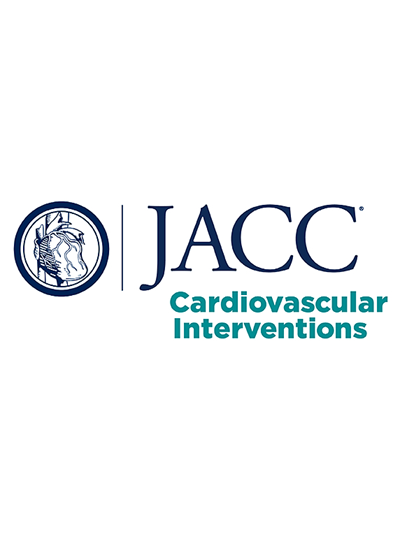残余二尖瓣反流与左心房压力不匹配可预测经导管边缘到边缘修复术后的预后
IF 11.7
1区 医学
Q1 CARDIAC & CARDIOVASCULAR SYSTEMS
引用次数: 0
摘要
背景经导管边缘到边缘修补术(TEER)后残余二尖瓣反流(MR)和术后左心房压(LAP)不匹配的机制和影响可能会对临床预后产生不利影响,这一点备受关注。目的本研究旨在通过前瞻性多中心登记研究,探讨经导管边缘到边缘修补术后血流动力学不匹配对重度MR所致心衰患者临床预后的影响,并研究不匹配的预测因素。方法我们将1,477名患者分为最佳组(残余MR分级≤1级且术后LAP≤15 mm Hg)、不匹配组(残余MR分级>1级或术后LAP>15 mm Hg)和不良组(残余MR分级>1级且术后LAP>15 mm Hg),并研究了他们的预后。主要终点是全因死亡率和心力衰竭住院率的复合值。结果分别有 927(62.7%)、459(31.1%)和 91(6.2%)名患者被分为最佳组、不匹配组和不良组。参照最佳组进行的 Cox 回归分析显示,不匹配组和不良组的主要终点风险更高(HR:1.55;95% CI:1.28-1.88;HR:1.95;95% CI:1.38-2.74)。结论 TEER 术后残余 MR 与术后 LAP 之间的血流动力学不匹配与不良预后有关。六项容易获得的围手术期参数可预测血流动力学不匹配。(OCEAN-Mitral 登记;UMIN000023653)本文章由计算机程序翻译,如有差异,请以英文原文为准。
Mismatch Between Residual Mitral Regurgitation and Left Atrial Pressure Predicts Prognosis After Transcatheter Edge-to-Edge Repair
Background
The mechanism and impact of mismatch between residual mitral regurgitation (MR) and postprocedural left atrial pressure (LAP) after transcatheter edge-to-edge repair (TEER), which may adversely affect clinical outcome, is of great interest.
Objectives
This study aimed to examine the effect of hemodynamic mismatch after TEER on clinical outcomes in patients with heart failure due to severe MR and investigate the predictive factors for the mismatch using a prospective multicenter registry.
Methods
We categorized 1,477 patients into optimal (residual MR grade ≤1 and postprocedural LAP ≤15 mm Hg), mismatched (residual MR grade >1 or postprocedural LAP >15 mm Hg), and poor (residual MR grade >1 and postprocedural LAP >15 mm Hg) groups and examined their prognosis. The primary endpoint was a composite of all-cause mortality and heart failure hospitalization.
Results
There were 927 (62.7%), 459 (31.1%), and 91 (6.2%) patients categorized into optimal, mismatched, and poor groups, respectively. Cox regression analysis, referenced to the optimal group, revealed that the mismatched and poor groups exhibited a higher risk for the primary endpoint (HR: 1.55; 95% CI: 1.28-1.88; and HR: 1.95; 95% CI: 1.38-2.74, respectively). Six risk factors were identified as predictors of hemodynamic mismatch after TEER: body mass index, baseline left atrial volume index, atrial fibrillation, tricuspid annular plane systolic excursion value, preprocedural mean left atrial pressure, and postprocedural mean mitral valve pressure gradient.
Conclusions
Post-TEER hemodynamic mismatch between residual MR and postprocedural LAP was associated with a poor prognosis. Six readily accessible perioperative parameters predict the hemodynamic mismatch. (OCEAN-Mitral registry; UMIN000023653)
求助全文
通过发布文献求助,成功后即可免费获取论文全文。
去求助
来源期刊

JACC. Cardiovascular interventions
CARDIAC & CARDIOVASCULAR SYSTEMS-
CiteScore
11.60
自引率
8.80%
发文量
756
审稿时长
4-8 weeks
期刊介绍:
JACC: Cardiovascular Interventions is a specialist journal launched by the Journal of the American College of Cardiology (JACC). It covers the entire field of interventional cardiovascular medicine, including cardiac, peripheral, and cerebrovascular interventions. The journal publishes studies that will impact the practice of interventional cardiovascular medicine, including clinical trials, experimental studies, and in-depth discussions by respected experts. To enhance visual understanding, the journal is published both in print and electronically, utilizing the latest technologies.
 求助内容:
求助内容: 应助结果提醒方式:
应助结果提醒方式:


